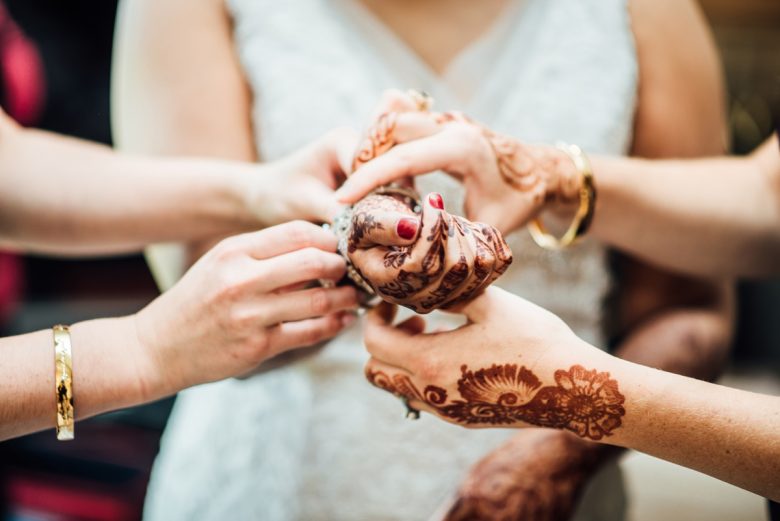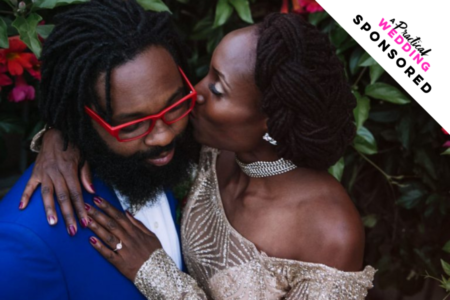
Jumping over a broom, donning intricate henna hand designs, licking honey off your partner’s pinky finger, smashing dishware, eating a black cake: weddings around the world are culturally rich ceremonies in traditions and symbols. But you know what tradition also is? Old, as in, from that time when wives belonged to their husbands and their main duties were to pop out healthy boys. So, while honoring culture through ritual can be deeply important, thinking through wedding traditions from an egalitarian point of view can also be a challenge.
Today we’re launching our new series, Wedding Ceremonies for Feminists, which allow us to learn about ceremonies all over the world… and the perspective of feminists who have balanced their cultural values with their political ones. No one post can speak for a whole culture (or all feminists in a culture), but we hope the perspective of one person who’s navigated through a particular ceremony will inform and inspire. The goal is to help those of you who are trying to honor your heritage while questioning how rituals line up with your values. And for the rest of us, hopefully this reminds us that not all wedding ceremonies end with, “With this ring, I thee wed…”
As a second generation Indian-American, the first generation born and raised in America, there have been many times where I’ve felt disconnected or removed from my ethnicity and culture. Growing up in one country while simultaneously trying to understand the cultural nuances of another is trying, to say the least. My parents raised us to always question, be curious, and resist blind belief. But even still, I’m sure they tired of the constant disagreement to a religion based so much on complex rituals and ceremonies.
All of this came to a head when it came time to plan our wedding. I had put my foot down; I would not take part in things that had “no meaning” to me or were seemingly silly or pointless. My husband, on the other hand, has always been inclined to think traditions are “nice”—meaningful to follow in the footsteps of others, and harmless, even if you don’t believe. It seemed harsh, but as someone who was growing increasingly frustrated with the continual conflict of a traditionally feminist religion (Hinduism is a Polytheistic religion with a lot of emphasis placed on various goddesses and other strong female figures) and a seemingly chauvinist culture (Indian culture is very male-centric, with women traditionally playing a subservient role) I was not ready to give in. Before I was married via a traditional Hindu wedding ceremony, I needed to know that marriage, in the context of religion and culture, meant what I thought it to mean—an equal partnership based on mutual respect, commitment and love.
Knowing the meanings behind beliefs has always been very important to me, and digging into Hindu weddings ceremonies a bit definitely helped ease my already tense mind. Now, sure, there are parts of the ritual that I don’t necessarily stand behind. But, for the most part, the foundation of the ceremony seemed to be based largely on mutual acceptance and partnership. That’s exactly what I needed to see in order to partake… and it didn’t hurt that it made my mom happy.
The fact that the ceremony is about two hours long (on a short day), however, is something I don’t think I’ll ever come to terms with. When a ceremony is so largely based on ritualistic tradition and ancient scripture recitation (the ritual often seems short and concise, but the accompanying scripture may be much longer), there is a lot of room for variation between priests; this translates to a ceremony length of at least two to three hours. Spoiler alert: it’s definitely going to cut into cocktail hour time.
![]()
WHAT: Hindu Wedding Ceremony
WHO: The majority of people who participate in Hindu wedding ceremonies are those who follow the Hindu religion. Hinduism, however, is somewhat similar to Judaism in the sense that the culture and religion are often woven together. So, sometimes, those who don’t necessarily consider themselves Hindu participate due to their Indian heritage. For the most part, the Hindu wedding is also seen as the Indian wedding (though their are various other types of ceremonies for those who follow Indian-Islamic or Indian-Christian religions).
The Basics: Hindu weddings are often epically grand, with a lot of colorful clothing and decor, and plenty of celebratory dancing, music and food. Hindu weddings typically span the course of a few days, with pre- and post-wedding ceremonies and celebration. Here in the States, couples usually take the liberty of deciding which ceremonies and rituals they will participate in based on what is feasible for the couple and their families, both financially and time-wise. The wedding ceremony itself is the main event; it has a few key common rituals that involve many symbolic gestures. Since there are so many sects of the Hindu religion, there is no single standard Hindu marriage ceremony. Regional variations and considerable flexibility in the rituals are prevalent. These are just the basics.
THE POLITICS: After diving deeper into the foundation of Hindu marriage ceremonies, I feel that it’s a fairly even ceremony. There are definitely “giving away” and “owning” themes, but from what I understand about ceremonies from other cultures and traditions, these seem to be fairly universal due to the age of such traditions; Hinduism, as a religion, is pretty open, and often tweaks can be made with the ceremony. In terms of LGBT acceptance, the issue is, again, the dichotomy between Hindu religion and Indian culture. Hinduism is a fairly open and accepting religion. There are a number of mythological stories that portray homosexual experience as natural and joyful. There’s also temples whose ancient carvings include both men and women engaging in homosexual sex. However, sexuality in general is a taboo subject in Indian culture, and homosexuality was illegal in India until 2009. Though there are priests who oppose the concept of a Hindu gay marriage, there are others who believe that marriage is a union of spirit and is transcendental to gender.
Note on Gendered Language: Because this ceremony was traditionally constructed around the concepts of “bride” and “groom,” we’ve used gendered language here, though we’d love to hear about people’s experience with LGBTQ Hindu weddings, as well.
Length: 2 to 3 hours
The Nitty Gritty: There are a few key rituals common in a Hindu wedding ceremony. These are:
Baraat: The arrival of the groom and groom’s family (often on a horse or elephant, surrounded by drum players and lots of dancing).
Kanyadaan: The Kanyadaan ceremony is performed by the father or guardian of the bride. (Man, mother’s are left out here, too.) The father brings the daughter, then takes the bride’s hand and places it to the groom’s. The groom accepts the bride’s hand, while the kama-sukta (hymn to love) is pronounced, in the presence of the father, the bride, and the groom. The Kamasukta verse is:
Who offered this maiden?, to whom is she offered?
Kama (the god of love) gave her to me, that I may love her
Love is the giver, love is the acceptor
Enter thou, the bride, the ocean of love
With love then, I receive thee
May she remain thine, thine own, O god of love
Verily, thou art, prosperity itself
May the heaven bestow thee, may the earth receive thee
After this ritual recital, the father asks the groom to not fail the girl in his pursuit of dharma (moral and lawful life), artha (wealth), and kama (love). The groom promises to the bride’s father that he shall never fail her in his pursuit of dharma, artha, and kama. The groom repeats the promise three times. Now, this may not seem very girl-power-esque, but the way I see it is, feminist or not, I will always be okay with my father asking (telling?) my husband to keep me safe, honest, and protected. As a mother of a little boy who may choose to one day be a groom, I’m sure I would ask the same of his partner. Feminist modifications can likely (no promises if you pick the wrong priest) be made with the priest performing the ceremony if the couple wishes, and perhaps having a mother of the son giving him to the daughter (or some fun way of balancing the whole bride-as-object that’s being given away paradigm).
Sankalpa: In a decidedly egalitarian step, the couple has to place garlands on one another as a symbol of mutual approval before the ceremony can proceed.
Vivaha-Homa: Not entirely required, but a generally performed rite wherein a symbolic fire is lit by the groom to mark the start of a new household.
Panigrahana: A ritual knows as the “holding the hand,” which is meant to symbolize the union to come. During this portion, the groom announces that he accepts his responsibility to four deities: Bhaga (wealth), Aryama (heavens/milky way), Savita (radiance/new beginning), and Purandhi (wisdom). (Note: In Gujarati weddings, like ours, this step is called Hast-Milap, literally, meeting of hands.) The groom has to face west, while the bride sits in front of him facing east. He holds her hand while the following (again, remarkably balanced) Vedic mantra is recited:
I take thy hand in mine, yearning for happiness
I ask thee, to live with me, as thy husband
Till both of us, with age, grow oldKnow this, as I declare, that the Gods
Bhaga, Aryama, Savita, and Purandhi, have bestowed thy person, upon me
that I may fulfill, my Dharmas of the householder, with theeThis I am, That art thou
The Sāman I, the Ŗc thou
The Heavens I, the Earth thou
Saptapadi: The Saptapadi (seven steps/feet in Sanskrit), is the crux of the Vedic Hindu weddings because it represents the legally binding portion of Hindu marriage. The couple circles the fire, which is considered a witness to their union. Then, the bride and groom are bound together. In certain regions, that happens by tying a piece of clothing or sashes worn by the bride and groom together. Elsewhere, the groom holds the bride’s right hand in his own right hand. Then, depending again on region, the circle around the consecrated fire is led by either the bride or the groom. In most instances, the bride leads the groom in the first round. (Yes!) With each round, the couple makes a specific vow to establish some aspect of a happy relationship and household for each other.
There are long, short, and everything in between versions of the seven steps. The basic idea of these steps follows:
With the first step, we will provide for and support each other.
With the second step, we will develop mental, physical, and spiritual strength.
With the third step, we will share the worldly possessions.
With the fourth step, we will acquire knowledge, happiness, and peace.
With the fifth step, we will raise strong and virtuous children.
With the sixth step, we will enjoy the fruits of all seasons.
With the seventh step, we will always remain friends and cherish each other.
In a South Indian wedding, after each saying a mantra at each of the seven steps, the couple says these words together:
Now let us make a vow together. We shall share love, share the same food, share our strengths, share the same tastes. We shall be of one mind, we shall observe the vows together. I shall be the Samaveda, you the Rigveda, I shall be the Upper World, you the Earth; I shall be the Sukhilam, you the Holder—together we shall live and beget children, and other riches; come thou, O beautiful girl!
In North Indian weddings, the couple says the following words after completing all of the seven steps:
We have taken the Seven Steps. You have become mine forever. Yes, we have become partners. I have become yours. Hereafter, I cannot live without you. Do not live without me. Let us share the joys. We are word and meaning, united. You are thought and I am sound. May the night be honey-sweet for us. May the morning be honey-sweet for us. May the earth be honey-sweet for us. May the heavens be honey-sweet for us. May the plants be honey-sweet for us. May the sun be all honey for us. May the cows yield us honey-sweet milk. As the heavens are stable, as the earth is stable, as the mountains are stable, as the whole universe is stable, so may our union be permanently settled.
After the Seven Steps, the couple is considered married. Then comes blessings and prayers from family members, and epic celebrations.
A Note on Cultural Appropriation: This series is about respecting and celebrating sacred traditions (aka cultural exchange), not ideas to incorporate into your wedding. If you’re unsure if you’re appropriating, you could read this great 101 on the subject, or Google “[x element] cultural appropriation” and see if anything comes up. It’s a grey area… but generally if a culture you are not directly connected to has been oppressed, exoticized, or experienced forced assimilation, it’s best to be prudent.
Did you have a traditional wedding ceremony? TELL US about it!






